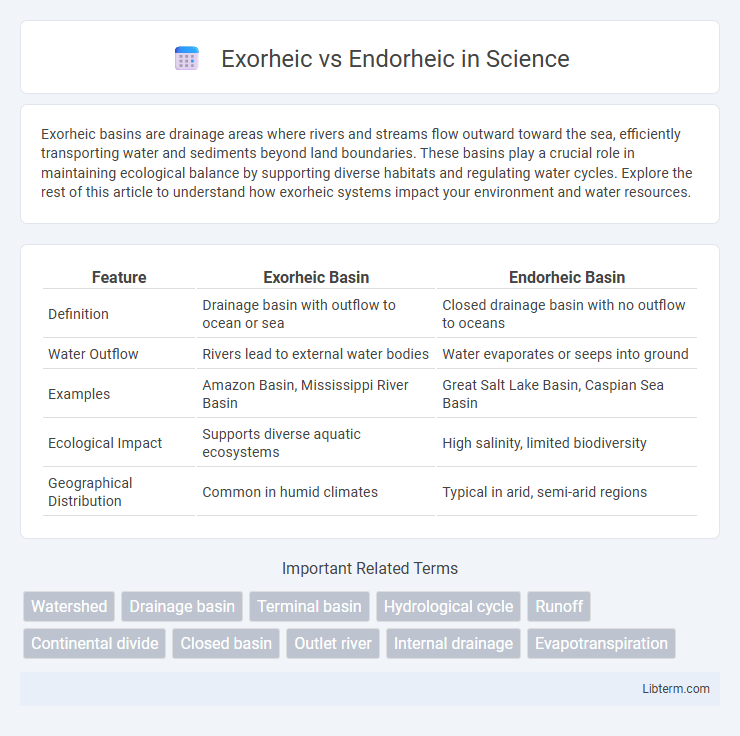Exorheic basins are drainage areas where rivers and streams flow outward toward the sea, efficiently transporting water and sediments beyond land boundaries. These basins play a crucial role in maintaining ecological balance by supporting diverse habitats and regulating water cycles. Explore the rest of this article to understand how exorheic systems impact your environment and water resources.
Table of Comparison
| Feature | Exorheic Basin | Endorheic Basin |
|---|---|---|
| Definition | Drainage basin with outflow to ocean or sea | Closed drainage basin with no outflow to oceans |
| Water Outflow | Rivers lead to external water bodies | Water evaporates or seeps into ground |
| Examples | Amazon Basin, Mississippi River Basin | Great Salt Lake Basin, Caspian Sea Basin |
| Ecological Impact | Supports diverse aquatic ecosystems | High salinity, limited biodiversity |
| Geographical Distribution | Common in humid climates | Typical in arid, semi-arid regions |
Introduction to Exorheic and Endorheic Systems
Exorheic systems are characterized by rivers and streams that flow outward into the ocean, maintaining a continuous drainage network, while endorheic systems contain basins where water accumulates without reaching external bodies, leading to internal drainage. These contrasting hydrological patterns significantly influence regional ecosystems and water availability, with exorheic basins supporting expansive aquatic habitats and endorheic basins often hosting saline lakes or seasonal wetlands. Understanding the dynamics of exorheic and endorheic systems is crucial for managing water resources and predicting ecological responses to climate variations.
Defining Exorheic Drainage Basins
Exorheic drainage basins are characterized by rivers and streams that flow outward, ultimately discharging into the ocean or sea, facilitating continuous water drainage from the land. These basins are vital for maintaining ecological balance by supporting diverse aquatic habitats and transporting nutrients across large geographical areas. Unlike endorheic basins, exorheic systems have outlets that prevent water from accumulating, reducing the risk of salt buildup and creating dynamic hydrological networks.
Understanding Endorheic Drainage Basins
Endorheic drainage basins are closed hydrological systems where water does not flow out to the ocean but instead accumulates in lakes or evaporates, leading to high salinity levels. These basins are typically found in arid or semi-arid regions, such as the Caspian Sea basin and the Great Salt Lake basin, where evaporation exceeds inflow. Understanding endorheic basins is crucial for managing water resources and ecological balance, as they influence local climate, water quality, and biodiversity within isolated catchments.
Key Differences Between Exorheic and Endorheic Basins
Exorheic basins are drainage areas where water flows outward to the ocean or a sea, facilitating continuous water exchange and sediment transport. Endorheic basins, by contrast, are closed drainage systems where water converges and evaporates or seeps into the ground, preventing outflow to external bodies of water. Key differences include their hydrological connectivity, water balance, and influence on local ecosystems, with exorheic basins supporting more dynamic aquatic environments while endorheic basins often form saline lakes or playas due to water evaporation.
Global Distribution of Exorheic and Endorheic Systems
Exorheic systems, characterized by rivers that drain into the ocean, dominate global landscapes such as the Amazon, Nile, and Mississippi basins, covering approximately 70% of the Earth's land surface. Endorheic basins, where water does not reach the ocean but instead collects in inland lakes or evaporates, are prevalent in arid and semi-arid regions like the Caspian Sea, Great Salt Lake, and the Aral Sea regions. These contrasting drainage patterns reflect global climatic and topographic conditions, with exorheic basins typically found in humid zones and endorheic basins primarily in enclosed desert environments.
Hydrological Processes in Exorheic Basins
Exorheic basins are characterized by outward drainage systems where water flows toward external oceans or seas, facilitating continuous surface runoff and nutrient transport. Hydrological processes in exorheic basins involve precipitation, infiltration, evapotranspiration, and surface runoff that contribute to river discharge and sediment fluxes. These dynamic fluxes regulate freshwater availability and influence biogeochemical cycles across diverse landscapes connected to global water bodies.
Hydrological Processes in Endorheic Basins
Endorheic basins are closed hydrological systems where water does not drain into external bodies such as oceans or rivers, resulting in internal drainage and high rates of evaporation, which concentrate minerals and salts. These basins rely predominantly on evapotranspiration to balance water inputs from precipitation and inflows, often leading to the formation of saline lakes or playas. The absence of outflow in endorheic basins significantly influences groundwater recharge, water quality, and ecosystem dynamics distinct from exorheic basins.
Environmental Impacts and Challenges
Exorheic basins discharge water into oceans or seas, promoting nutrient cycling and supporting diverse ecosystems, but they face challenges such as pollution and altered flow from urbanization. Endorheic basins, which retain water internally causing high salinity and evaporation rates, create unique habitats but are vulnerable to water scarcity, salinization, and habitat loss from human activities and climate change. Both basin types require targeted management to mitigate environmental impacts, including contamination control in exorheic systems and sustainable water use in endorheic systems.
Examples of Major Exorheic and Endorheic Basins
The Amazon Basin exemplifies a major exorheic basin, draining into the Atlantic Ocean and supporting extensive biodiversity. The Caspian Sea Basin represents a significant endorheic basin, characterized by its lack of outflow and internal drainage system, leading to saline water accumulation. Other prominent exorheic systems include the Mississippi River Basin, while the Great Salt Lake Basin in the United States stands as a key example of an endorheic basin.
Importance of Basin Types in Water Resources Management
Exorheic basins, which drain into the ocean, play a critical role in sustaining large-scale hydrological cycles and supporting water supply for agriculture, industry, and urban areas. Endorheic basins, characterized by internal drainage with no outflow to external bodies, are vital for managing water balance in arid regions and maintaining unique ecosystems. Understanding these basin types aids in optimizing water resource allocation, flood control, and ecosystem preservation under changing climate conditions.
Exorheic Infographic

 libterm.com
libterm.com